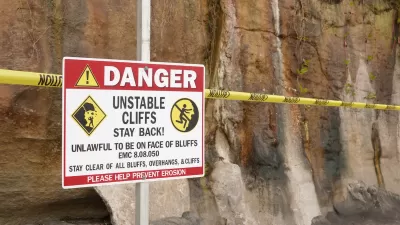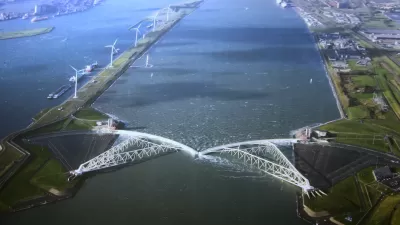It's not just melting ice that threatens to submerge communities along the East Coast of the U.S. Several other factor are conspiring to raise sea levels. Scientists are racing against time to predict how bad things are going to get, and how fast.
"Scientists have spent decades examining all the factors that can influence the rise of the seas, and their research is finally leading to answers," writes Justin Gillis. "And the more the scientists learn, the more they perceive an enormous risk for the United States."
Scientists believe that rising seas will be acutely felt along the East Coast, where "[m]uch of the population and economy of the country is concentrated" and a confluence of forces (which may have begun 35 million years ago) are conspiring to accelerate long-term trends.
"Scientists say the East Coast will be hit harder for many reasons, but among the most important is that even as the seawater rises, the land in this part of the world is sinking," observes Gillis. "And that goes back to the last ice age, which peaked some 20,000 years ago."
"Up and down the Eastern Seaboard, municipal planners want to know: How bad are things going to get, and how fast?"
FULL STORY: The Flood Next Time

Planetizen Federal Action Tracker
A weekly monitor of how Trump’s orders and actions are impacting planners and planning in America.

Maui's Vacation Rental Debate Turns Ugly
Verbal attacks, misinformation campaigns and fistfights plague a high-stakes debate to convert thousands of vacation rentals into long-term housing.

Restaurant Patios Were a Pandemic Win — Why Were They so Hard to Keep?
Social distancing requirements and changes in travel patterns prompted cities to pilot new uses for street and sidewalk space. Then it got complicated.

In California Battle of Housing vs. Environment, Housing Just Won
A new state law significantly limits the power of CEQA, an environmental review law that served as a powerful tool for blocking new development.

Boulder Eliminates Parking Minimums Citywide
Officials estimate the cost of building a single underground parking space at up to $100,000.

Orange County, Florida Adopts Largest US “Sprawl Repair” Code
The ‘Orange Code’ seeks to rectify decades of sprawl-inducing, car-oriented development.
Urban Design for Planners 1: Software Tools
This six-course series explores essential urban design concepts using open source software and equips planners with the tools they need to participate fully in the urban design process.
Planning for Universal Design
Learn the tools for implementing Universal Design in planning regulations.
Heyer Gruel & Associates PA
JM Goldson LLC
Custer County Colorado
City of Camden Redevelopment Agency
City of Astoria
Transportation Research & Education Center (TREC) at Portland State University
Jefferson Parish Government
Camden Redevelopment Agency
City of Claremont





























